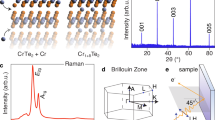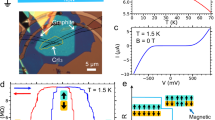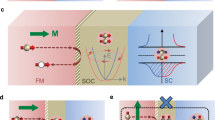Abstract
Electron tunnelling in solids, a fundamental quantum phenomenon, lays the foundation for various modern technologies. The emergence of van der Waals magnets presents opportunities for discovering unconventional tunnelling phenomena. Here, we demonstrate quantum tunnelling with tunable spin geometric phases in a multilayer van der Waals antiferromagnet CrPS4. The spin geometric phase of electron tunnelling is controlled by magnetic-field-dependent metamagnetic phase transitions. The square lattice of a CrPS4 monolayer causes strong t2g-orbital delocalization near the conduction band minimum. This creates a one-dimensional spin system with reversed energy ordering between the t2g and eg spin channels, which prohibits both intralayer spin relaxation by means of collective magnon excitations and interlayer spin hopping between the t2g and eg spin channels. The resulting coherent electron transmission shows pronounced tunnel magnetoresistance oscillations, manifesting quantum interference of cyclic quantum evolutions of individual electron Bloch waves by means of the time-reversal symmetrical tunnelling loops. Our results suggest the appearance of Aharonov–Anandan phases that originate from the non-adiabatic generalization of the Berry’s phase.
This is a preview of subscription content, access via your institution
Access options
Access Nature and 54 other Nature Portfolio journals
Get Nature+, our best-value online-access subscription
27,99 € / 30 days
cancel any time
Subscribe to this journal
Receive 12 print issues and online access
269,00 € per year
only 22,42 € per issue
Buy this article
- Purchase on SpringerLink
- Instant access to full article PDF
Prices may be subject to local taxes which are calculated during checkout




Similar content being viewed by others
Data availability
The authors declare that the main data supporting the findings of this study are available within the paper and its Supplementary Information files. Source data are provided with this paper. Extra data are available from the corresponding authors upon request.
References
Esaki, L. New phenomenon in narrow germanium p-n junctions. Phys. Rev. 109, 603 (1958).
Sze, S. M. & Lee, M. K. Semiconductor Devices: Physics and Technology (Wiley, 2012).
Binning, G., Rohrer, H., Gerber, C. & Weibel, E. Surface studies by scanning tunneling microscopy. Phys. Rev. Lett. 49, 57–61 (1982).
Fowler, R. H. & Nordheim, L. Electron emission in intense electric field. Proc. R. Soc. A 119, 173–181 (1928).
Giaever, I. Energy gap in superconductors measured by electron tunneling. Phys. Rev. Lett. 5, 147–148 (1960).
Josephson, B. D. Possible new effects in superconductive tunnelling. Phys. Lett. 1, 251–253 (1962).
Katsnelson, M. I., Novoselov, K. S. & Geim, A. K. Chiral tunnelling and the Klein paradox in graphene. Nat. Phys. 2, 620–625 (2006).
Young, A. F. & Kim, P. Quantum interference and Klein tunnelling in graphene heterojunctions. Nat. Phys. 5, 222–226 (2009).
Huang, B. et al. Layer-dependent ferromagnetism in a van der Waals crystal down to the monolayer limit. Nature 546, 270–273 (2017).
Gong, C. et al. Discovery of intrinsic ferromagnetism in two-dimensional van der Waals crystals. Nature 546, 265–269 (2017).
Fei, Z. et al. Two-dimensional itinerant Ising ferromagnetism in atomically thin Fe3GeTe2. Nat. Mater. 17, 778–782 (2018).
Deng, Y. et al. Gate-tunable room-temperature ferromagnetism in two-dimensional Fe3GeTe2. Nature 563, 94–99 (2018).
Worledge, D. C. & Geballe, T. H. Magnetoresistive double spin filter tunnel junction. J. Appl. Phys. 88, 5277–5279 (2000).
Klein, D. R. et al. Probing magnetism in 2D van der Waals crystalline insulators via electron tunneling. Science 360, 1218–1222 (2018).
Wang, Z. et al. Determining the phase diagram of atomically thin layered antiferromagnet CrCl3. Nat. Nanotechnol. 14, 1116–1122 (2019).
Peng, Y. et al. Magnetic structure and metamagnetic transitions in the van der Waals antiferromagnet CrPS4. Adv. Mater. 32, 202001200 (2020).
Qiu, Z. et al. Visualizing atomic structure and magnetism of 2D magnetic insulators via tunneling through graphene. Nat. Commun. 12, 70 (2021).
Song, T. et al. Giant tunneling magnetoresistance in spin-filter van der Waals heterostructures. Science 360, 1214–1218 (2018).
Ghazaryan, D. et al. Magnon-assisted tunnelling in van der Waals heterostructures based on CrBr3. Nat. Electron. 1, 344–349 (2018).
Zhang, M. J. et al. Spin-lattice coupled metamagnetism in frustrated van der Waals magnet CrOCl. Small 19, 2300964 (2023).
Miao, G., Müller, M. & Moodera, J. S. Magnetoresistance in double spin filter tunnel junctions with nonmagnetic electrodes and its unconventional bias dependence. Phys. Rev. Lett. 102, 076601 (2009).
Nagamiya, T., Yosida, K. & Kubo, R. Antiferromagnetism. Adv. Phys. 4, 1–112 (1955).
Leggett, A. J. et al. Dynamics of the dissipative two-state system. Rev. Mod. Phys. 67, 725 (1995).
Zhang, X. X. & Nagaosa, N. Dissipative Berry phase effect in quantum tunneling. Phys. Rev. B 102, 245426 (2020).
Loss, D., DiVincenzo, D. P. & Grinstein, G. Suppression of tunneling by interference in half-integer-spin particles. Phys. Rev. Lett. 69, 3232 (1992).
von Delft, J. & Henley, C. L. Destructive quantum interference in spin tunneling problems. Phys. Rev. Lett. 69, 3236 (1992).
Berry, M. V. Quantal phase factors accompanying adiabatic changes. Proc. R. Soc. Lond. A 392, 45–47 (1984).
Aharonov, Y. & Anandan, J. Phase change during a cyclic quantum evolution. Phys. Rev. Lett. 58, 1593 (1987).
Anandan, J. The geometric phase. Nature 360, 307–313 (1992).
Bud’ko, S. L., Gati, E., Slade, T. J. & Canfield, P. C. Magnetic order in the van der Waals CrPS4: anisotropic H–T phase diagrams and effects of pressure. Phys. Rev. B 103, 224407 (2021).
Son, J. et al. Air-stable and layer-dependent ferromagnetism in atomically thin van der Waals CrPS4. ACS Nano 15, 16904–16912 (2021).
Greenaway, M. et al. Resonant tunnelling between the chiral Landau states of twisted graphene lattices. Nat. Phys. 11, 1057–1062 (2015).
Nagaswa, F., Takagi, J., Kunihashi, Y., Kohda, M. & Nitta, J. Experimental demonstration of spin geometric phase: radius dependence of time-reversal Aharonov–Casher oscillations. Phys. Rev. Lett. 108, 086801 (2012).
Nagaswa, F., Frustaglia, D., Saarikoski, H., Richter, K. & Nitta, J. Control of the spin geometric phase in semiconductor quantum rings. Nat. Commun. 4, 2526 (2013).
Loss, D., Goldbart, P. & Balasky, A. V. Berry’s phase and persistent charge and spin currents in textured mesoscopic rings. Phys. Rev. Lett. 65, 1655 (1990).
Aronov, A. G. & Lyanda-Geller, Y. B. Spin-orbit Berry phase in conducting rings. Phys. Rev. Lett. 70, 343 (1993).
Qian, T.-Z. & Su, Z.-B. Spin-orbit interaction and Aharonov-Anandan phase in mesoscopic rings. Phys. Rev. Lett. 72, 2311 (1994).
Meijer, F. E., Morpurgo, A. F. & Klapwikj, T. M. One-dimensional ring in the presence of Rashba spin-orbit interaction: derivation of the correct Hamiltonian. Phys. Rev. B 66, 033107 (2002).
Nitta, J., Meijer, F. E. & Takayanagi, H. Spin-interference device. Appl. Phys. Lett. 75, 695–697 (1999).
Aharonov, Y. & Bohm, D. Significance of electromagnetic potentials in the quantum theory. Phys. Rev. 115, 485 (1959).
Al’tshuler, B. L., Aronov, A. G. & Spivak, B. Z. The Aharonov–Bohm effect in disordered conductors. JETP Lett. 33, 94 (1981).
Frustaglia, D. & Richter, K. Spin interference effects in ring conductors subject to Rashba coupling. Phys. Rev. B 69, 235310 (2004).
Wu, F. et al. Quasi-1D electronic transport in a 2D magnetic semiconductor. Adv. Mater. 34, 2109759 (2022).
Zomer, P. J., Guimarães, M. H. D., Brant, J. C., Tombros, N. & van Wees, B. J. Fast pick up technique for high quality heterostructures of bilayer graphene and hexagonal boron nitride. Appl. Phys. Lett. 105, 013101 (2014).
Kresse, G. & Hafner, J. Ab initio molecular dynamics for liquid metals. Phys. Rev. B 47, 558 (1993).
Kresse, G. & Furthmuller, J. Efficient iterative schemes for ab initio total-energy calculations using a plane-wave basis set. Phys. Rev. B 54, 11169 (1996).
Perdew, J. P., Burke, K. & Ernzerhof, M. Generalized gradient approximation made simple. Phys. Rev. Lett. 77, 3865 (1996).
Blochl, P. E. Projector augmented-wave method. Phys. Rev. B 50, 17953 (1994).
Grimme, S., Ehrlich, S. & Goerigk, L. Effect of the damping function in dispersion corrected density functional theory. J. Comput. Chem. 32, 1456–1465 (2011).
Dudarev, S. L., Botton, G. A., Savrasov, S. Y., Humphreys, C. J. & Sutton, A. P. Electron-energy-loss spectra and the structural stability of nickel oxide: an LSDA+U study. Phys. Rev. B 57, 1505 (1998).
Heyd, J., Scuseria, G. E. & Ernzerhof, M. Hybrid functionals based on a screened Coulomb potential. J. Chem. Phys. 118, 8207 (2003).
Acknowledgements
This work was supported by the National Key R&D Programme of the MOST of China (Grant No. 2023YFA1406302 to Y.Z.), the National Science Foundation of China (Grant Nos. 12374194 and 12241401 to Y.Z. and J.B.Y., respectively) and the Zhejiang Provincial Natural Science Foundation (D19A040001 to Y.Z.). Y.Z. acknowledges support from the Users with Excellence Project of Hefei Science Center CAS, 2021HSC-UE007.
Author information
Authors and Affiliations
Contributions
Y.Z. conceived and supervised the project. M.C., Q.F.H. and C.Y.D. synthesized CrPS4 single crystals, fabricated CrPS4 MTJs and carried out all the measurements. C.Q.H., Y.Q.H. and Y.H.L. did the DFT calculations. K.W. and T.T. prepared high-quality boron nitride single crystals. M.C., Q.F.H., Y.Q.H., C.Y.D. and Y.Z. analysed the data and wrote the paper with input from all authors.
Corresponding authors
Ethics declarations
Competing interests
The authors declare no competing interests.
Peer review
Peer review information
Nature Physics thanks the anonymous reviewers for their contribution to the peer review of this work.
Additional information
Publisher’s note Springer Nature remains neutral with regard to jurisdictional claims in published maps and institutional affiliations.
Extended data
Extended Data Fig. 1 Temperature-dependent TMR oscillations of CrPS4 MTJ device with H∥.
a, Temperature-dependent It vs H characteristics of the 6-layer CrPS4 MTJ device with NbSe2 contacts (Nb-D46). The saturation field Hsat and the constructive oscillation peaks (p1 and p2) at 2 K are marked by arrows. b, The derivative dI/dH of the data in (a). The black and olive dashed lines label the positions of Hsat and the oscillation peaks respectively.
Extended Data Fig. 2 AA geometric phase analyses of parallel quantum tunnelling in bilayer CrPS4 MTJ by the 1D AFM SOC ring model.
a, Parallel quantum tunnelling of an electron spin wave through a bilayer CrPS4 MTJ in the AFM ground state. The interlayer AFM coupling enforces interfacial spin-basis rotations with opposite directions for the \({\Psi }_{{e}_{g}}\) and \({\Psi }_{{t}_{2g}}\) pathways respectively, each contributes a half circling on the equatorial plane of the Bloch sphere, and thus, generates a spin geometric phase of π (a and c). Note that the spin geometric phase, which is decided by the spin winding number \({\mathbb{Z}}\) of the two-state spin system, is invariant under a TR operation (b and d).
Extended Data Fig. 3 Simulations of layer-dependent tunneling magnetoresistance of CrPS4 MTJs.
a, Simulation results by the PQT model, which show excellent consistency with the experimental results, including the even-odd starting AA phases and the (N-1)/2 quantum interference peak numbers. b, Simulation results by the multiple spin-filter model. In consistent with the previous literatures on CrX3, the multiple spin-filter model yields monotonic growth in tunneling magnetoresistance when the CrPS4 channels of different thicknesses are in the CAFM phase.
Extended Data Fig. 4 Layer-dependent TMR oscillations in CrPS4 MTJs using NbSe2 electrodes with consecutive thicknesses from 8 MLs to 2 MLs with Vb = 10 mV for H⊥.
These data are in complementary to Fig. 4b in the main text (H∥).
Extended Data Fig. 5 Vb-dependent evolutions in the TMR oscillations of 8-layer MTJ (D36) with graphene electrodes.
Due to the tilting of tunnelling barrier potential, Neff is reduced to 7 MLs for Vb = 80 mV and 6 MLs for Vb = 140 mV, respectively.
Supplementary information
Supplementary Information
Supplementary Notes 1–7, Table 1 and Figs. 1–21.
Source data
Source Data Fig. 1
Unprocessed source data.
Source Data Fig. 2
Unprocessed source data.
Source Data Fig. 3
Unprocessed source data.
Source Data Fig. 4
Unprocessed source data.
Source Data Extended Data Fig. 1
Unprocessed source data.
Source Data Extended Data Fig. 3
Unprocessed source data.
Source Data Extended Data Fig. 4
Unprocessed source data.
Source Data Extended Data Fig. 5
Unprocessed source data.
Rights and permissions
Springer Nature or its licensor (e.g. a society or other partner) holds exclusive rights to this article under a publishing agreement with the author(s) or other rightsholder(s); author self-archiving of the accepted manuscript version of this article is solely governed by the terms of such publishing agreement and applicable law.
About this article
Cite this article
Cheng, M., Hu, Q., Huang, Y. et al. Quantum tunnelling with tunable spin geometric phases in van der Waals antiferromagnets. Nat. Phys. 20, 1973–1979 (2024). https://doi.org/10.1038/s41567-024-02675-x
Received:
Accepted:
Published:
Issue Date:
DOI: https://doi.org/10.1038/s41567-024-02675-x



